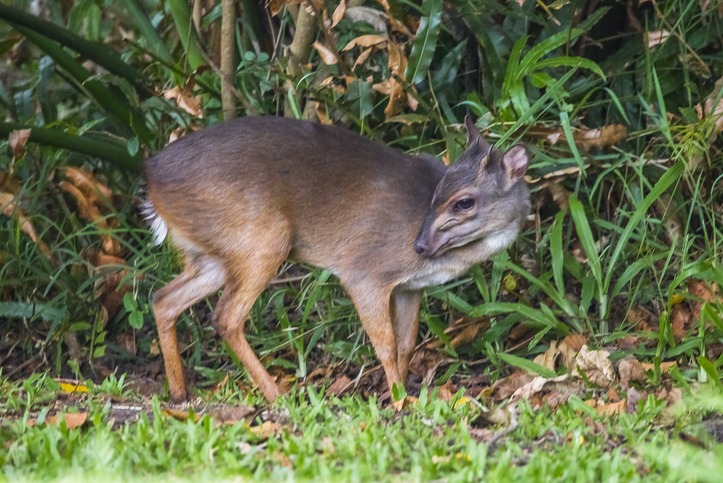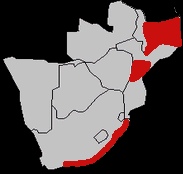The Blue Duiker, also known as the Philantomba monticola, is a small antelope that can be found in southern, western, and eastern Africa. This species is considered as the smallest duiker in the Bovidae family. The Blue Duiker’s closest relatives include Addaxes, Impalas, Elands, and Springboks.
This duiker species was first described in 1789 by Swedish naturalist Carl Peter Thunberg. The generic name Philantomba has no specific origin, whereas monticola was derived from the Latin terms montis, which means mountain, and colo, which means “I cultivate,” giving reference to its montane habitat. The “blue” refers to its usual coat colors. The common name duiker was based on the Afrikaans duik, which means diver, referring to their behavior of dicing into vegetation for cover.
16 subspecies of the Blue Duiker that have been categorized. Back in 2001, Groves and Grubb identified the subspecies and separated them into two groups, basing them on their coloration and geographical occurrence. The two groups are referred to as the grey-legged or northern subspecies and the red-legged or southern subspecies.
Since this species widely occurs in the African continent, the International Union for Conservation of Nature, or IUCN Red List, categorized this duiker species as Least Concern. Blue Duikers still remain threatened by hunting, habitat loss, and predators in the wild, but they have proven to be resilient duikers.
Its seven levels of scientific classification are as follows:
Kingdom: Animalia
Phylum: Chordata
Class: Mammalia
Order: Artiodactyla
Family: Bovidae
Genus: Philantomba
Species: P. monticola
The physical characteristics of a Blue Duiker
The smallest duiker species possesses features that are hard to miss. Its head-and-body length lies between 55 and 90 cm, its shoulder length stands between 32 and 41 cm, and it weighs from 3.5 to 9 kg. This species is sexually dimorphic, meaning male and female Blue Duikers have some differences in appearance. A female Blue Duiker is usually larger than males.
An adult Blue Duiker has a flat forehead, small ears with a white line, large eyes, large nostrils, agile lips, and broad mouth. Its dark tail measures more than 10 cm long. It has a row of white crinkly hairs that when the Blue Duiker moves it up and down, it looks like a glowing tail.
It also has short, spiky horns that stand around 5 cm. Blue Duiker subspecies show variety of variation in their colors. The shades range from blue to grey, brown, and black. Grey-legged northern species usually have grey or brown coloration, with a posterior strip that runs from the rump down the buttocks. The southern species typically have reddish legs and coats.
This duiker species shares a strong resemblance to Maxwell’s Duiker, which is usually larger than the former.
The distribution and habitat of Blue Duikers
This duiker species occurs in several African countries, particularly in Cameroon, Angola, Central African Republic, The Democratic Republic of Congo, Gabon, Kenya, Malawi, Mozambique, Nigeria, Rwanda, South Africa, Tanzania, Uganda, Zimbabwe, and Zambia. It lives on a wide range of habitats such as old-growth forests, gallery forests, and secondary forests.
The behavior of a Blue Duiker
Blue Duikers are diurnal, meaning they are most active during the day. They confine themselves in forest fringes because they are secretive and cautious. Of all antelopes, Blue Duikers have the largest brains relative to the size of their bodies. They are territorial mammals, too. A Blue Duiker will rub its preorbital glands on logs and trees to mark the territory with its fluid.
Blue Duikers are non-seasonal breeders and monogamous pairs that last together throughout the year. The gestational period length lasts from four months to seven months. Birth rate is higher in the dry season. The female Blue Duiker usually gives birth to only one calf. After 20 minutes of its birth, the calf can already start moving on its own. However, the calf remains nursed by its female parent for up to 3 months. Male Blue Duikers occasionally visit their mates, though they tend to disappear a month after the calf’s birth.
The diet of a Blue Duiker
This species feeds on fallen fruits, flowers, foliage, tree barks from forest canopies, resin, fungi, and ants, which are licked from surfaces. Compared to other duiker species, the Blue Duiker can sustain and nourish its body through feeding on dead foliage. A scientific study found out that Blue Duikers prefer fruits than foliage.
WILDLIFE PARKS AND RESERVES WHERE THIS SPECIES IS FOUND:
ZIMBABWE
Gona-re-Zhou


